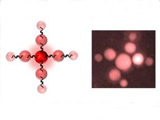Today.Az » Weird / Interesting » Researchers build an antenna for light
12 July 2011 [14:06] - Today.Az
 University of Toronto researchers have derived inspiration from the photosynthetic apparatus in plants to engineer a new generation of nanomaterials that control and direct the energy absorbed from light.
University of Toronto researchers have derived inspiration from the photosynthetic apparatus in plants to engineer a new generation of nanomaterials that control and direct the energy absorbed from light.
Their findings are reported in the journal Nature Nanotechnology.
The U of T researchers, led by Professors Shana Kelley and Ted
Sargent, report the construction of what they term "artificial
molecules."
"Nanotechnologists have for many years been captivated by quantum
dots -- particles of semiconductor that can absorb and emit light
efficiently, and at custom-chosen wavelengths," explained co-author
Kelley, a Professor at the Leslie Dan Faculty of Pharmacy, the
Department of Biochemistry in the Faculty of Medicine, and the
Department of Chemistry in the Faculty of Arts & Science. "What the
community has lacked -- until now -- is a strategy to build higher-order
structures, or complexes, out of multiple different types of quantum
dots. This discovery fills that gap."
The team combined its expertise in DNA and in semiconductors to
invent a generalized strategy to bind certain classes of nanoparticles
to one another.
"The credit for this remarkable result actually goes to DNA: its high
degree of specificity -- its willingness to bind only to a
complementary sequence -- enabled us to build rationally-engineered,
designer structures out of nanomaterials," said Sargent, a Professor in
The Edward S. Rogers Sr. Department of Electrical & Computer
Engineering at the University of Toronto, who is also the Canada
Research Chair in Nanotechnology. "The amazing thing is that our
antennas built themselves -- we coated different classes of
nanoparticles with selected sequences of DNA, combined the different
families in one beaker, and nature took its course. The result is a
beautiful new set of self-assembled materials with exciting properties."
Traditional antennas increase the amount of an electromagnetic wave
-- such as a radio frequency -- that is absorbed, and then funnel that
energy to a circuit. The U of T nanoantennas instead increased the
amount of light that is absorbed and funneled it to a single site within
their molecule-like complexes. This concept is already used in nature
in light harvesting antennas, constituents of leaves that make
photosynthesis efficient. "Like the antennas in radios and mobile
phones, our complexes captured dispersed energy and concentrated it to a
desired location. Like the light harvesting antennas in the leaves of a
tree, our complexes do so using wavelengths found in sunlight,"
explained Sargent.
"Professors Kelley and Sargent have invented a novel class of
materials with entirely new properties. Their insight and innovative
research demonstrates why the University of Toronto leads in the field
of nanotechnology," said Professor Henry Mann, Dean of the Leslie Dan
Faculty of Pharmacy.
"This is a terrific piece of work that demonstrates our growing
ability to assemble precise structures, to tailor their properties, and
to build in the capability to control these properties using external
stimuli," noted Paul S. Weiss, Fred Kavli Chair in NanoSystems Sciences
at UCLA and Director of the California NanoSystems Institute.
Kelley explained that the concept published in the Nature Nanotechnology paper is a broad one that goes beyond light antennas alone.
"What this work shows is that our capacity to manipulate materials at
the nanoscale is limited only by human imagination. If semiconductor
quantum dots are artificial atoms, then we have rationally synthesized
artificial molecules from these versatile building blocks."
Also contributing to the paper were researchers Sjoerd Hoogland and
Armin Fischer of The Edward S. Rogers Sr. Department of Electrical &
Computer Engineering, and Grigory Tikhomirov and P. E. Lee of the
Leslie Dan Faculty of Pharmacy.
The publication was based in part on work supported by the Ontario
Research Fund Research Excellence Program, the Natural Sciences and
Engineering Research Council of Canada (NSERC), Canada Research Chairs
program and the National Institutes of Health (NIH).
/Science Daily/
|